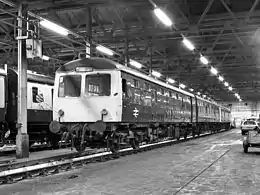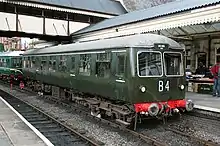British Rail Class 105
The British Rail Classes 105 and 106 diesel multiple units were built by Cravens Ltd. of Sheffield from 1956 to 1959. The class were built with a side profile identical to British Railways Mark 1 carriage stock, using the same doors and windows. None were selected for refurbishment. The last passenger car was withdrawn from service in 1988.
| British Rail Classes 105 and 106 | |
|---|---|
 Inside Longsight Diesel Traction Maintenance Depot, December 1983 | |
| In service | 1959–1988 |
| Manufacturer | Cravens |
| Family name | First generation |
| Replaced | Steam locomotives and carriages |
| Constructed | 1956–1959 |
| Number built | DMBS: 142, DTCL: 108, DMCL: 33, TCL 19. Total: 302 cars |
| Number preserved | 3 cars |
| Successor | Class 313 |
| Formation | 2-cars sets: DMBS-DTCL or DMBS-DMCL, 3 cars sets:DMBS-TCL-DMCL |
| Operator(s) | British Railways |
| Specifications | |
| Car body construction | Steel |
| Car length | 57 ft 6 in (17.53 m) |
| Width | 9 ft 3 in (2.82 m) |
| Height | 12 ft 7 in (3.84 m) |
| Doors | Slam |
| Maximum speed | 70 mph (113 km/h) |
| Weight | Power cars: 29.5 or 30.5 tonnes (29.0 or 30.0 long tons) Trailer cars: 23.5 or 24.5 tonnes (23.1 or 24.1 long tons) |
| Prime mover(s) | Two BUT |
| Power output | 150 bhp (112 kW) each engine |
| Transmission | Mechanical: 4 speed epicyclic gearbox |
| UIC classification | Power cars: 1A′A1′ Trailer cars: 2′2′ |
| Coupling system | Screw-link couplings , British Standard gangways |
| Multiple working | ■ Blue Square |
| Track gauge | 4 ft 8 1⁄2 in (1,435 mm) |


Usage

The Class 105 DMUs were used chiefly on Eastern Region services around Hull, Lincolnshire, East Anglia and local services to/From London King's Cross. Units initially designated to work on the former Midland and Great Northern Joint Railway lines were moved to services from London King's Cross upon the closure of the M&GN joint lines in 1959. Units were also used on the London Midland Region and in Scotland, particularly in Aberdeenshire. The closure of many of these lines in the 1960s resulted in their dispersal throughout Great Britain, notably to Tysley depot near Birmingham. The electrification of the lines from London King's Cross and the introduction of the Class 313 EMUs in 1976 led to the withdrawal of many Cravens units.
Norwich was the last depot to operate the Cravens units, with set 30 being returned to green livery, and gaining some celebrity status towards the end of its service life. The unit was, however, contaminated with asbestos and consequently scrapped.
Orders
| Lot No. | Car type | Qty | Fleet numbers | Notes |
|---|---|---|---|---|
| 30280 | Driving Motor Brake Second (DMBS) | 14 | 50359–50372 | Power-trailer 2-car sets |
| 30281 | Driving Trailer Composite with lavatory (DTCL) | 14 | 56114–56127 | Power-trailer 2-car sets |
| 30282 | Driving Motor Brake Second (DMBS) | 17 | 50373–50389 | Power-trailer 2-car sets |
| 30283 | Driving Trailer Composite with lavatory (DTCL) | 17 | 56128–56144 | Power-trailer 2-car sets |
| 30284 | Driving Motor Brake Second (DMBS) | 5 | 50390–50394 | Power-trailer 2-car sets |
| 30285 | Driving Trailer Composite with lavatory (DTCL) | 5 | 56145–56149 | Power-trailer 2-car sets |
| 30352 | Driving Motor Brake Second (DMBS) | 33 | 50752–50784 | 2- or 3-car sets |
| 30353 | Driving Motor Composite with lavatory (DMCL) | 33 | 50785–50817 | 2- or 3-car sets |
| 30354 | Trailer Composite with lavatory (TCL) | 19 | 59307–59325 | 3-car sets |
| 30469 | Driving Motor Brake Second (DMBS) | 48 | 51254–51301 | Power-trailer 2-car sets |
| 30470 | Driving Trailer Composite with lavatory (DTCL) | 48 | 56412–56459 | Power-trailer 2-car sets |
| 30503 | Driving Motor Brake Second (DMBS) | 24 | 51471–51494 | Power-trailer 2-car sets |
| 30504 | Driving Trailer Composite with lavatory (DTCL) | 24 | 56460–56483 | Power-trailer 2-car sets |
| 30505 | Driving Motor Brake Second (DMBS) | 1 | 50249 | |
Technical details
- Builder: Cravens
- Introduced: 1956
- Coupling Code: Blue Square
- Body: 57 ft 6 in x 9 ft 2 in
- Engines: Two BUT, 150 bhp
- Transmission: Standard mechanical
For coupling codes see British United Traction
Preservation

Due to the use of asbestos in their construction, and extended usage by BR, the class has fared very badly in preservation. 51485 and 56121 were preserved by the West Somerset Railway but moved to the East Lancashire Railway in 1997 where they have been restored after asbestos stripping. 56456 is based on the Llangollen Railway, working initially with a Class 127. The National Railway Museum had intended to preserve 53812 - which had been stripped of asbestos but a lack of space prevented this car and the Class 100 coupled to it from being moved to York and they were vandalised beyond repair at Crewe.
| Number | Vehicle type | Location |
|---|---|---|
| 51485 | DMBS | East Lancashire Railway |
| 56121 | DTCL | East Lancashire Railway |
| 56456 | DTCL | Llangollen Railway |
References
- Motive Power Recognition: 3 DMUs. Colin J. Marsden
- British Railway Pictorial: First Generation DMUs. Kevin Robertson
- British Rail Fleet Survey 8: Diesel Multiple Units- The First Generation. Brian Haresnape
- A Pictorial Record of British Railways Diesel Multiple Units. Brian Golding
External links
| Wikimedia Commons has media related to British Rail Class 105. |